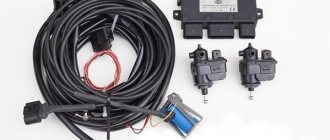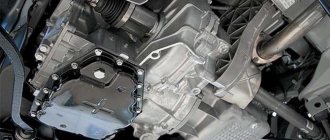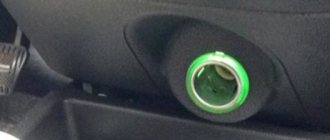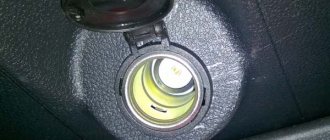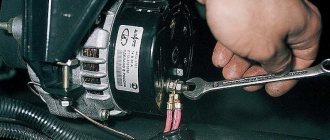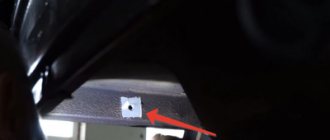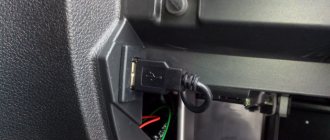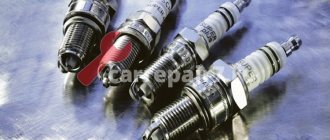The domestic Lada Granta is equipped with a hydraulic headlight corrector, which fails quite often, which is why many owners of this car are interested in how to carry out repairs with their own hands if the corrector does not work.
Hydrocorrector headlights appeared on such models in Russia as the VAZ 2105 and 2107. The innovation was immediately appreciated and accepted. Subsequently, it began to be installed on new cars of the automaker, including the Lada Granta.
Headlight correctors come in two types:
- • Electric headlight adjustment system.
- • Hydraulic installation that adjusts the headlight angle.
Step-by-step instructions for replacing the headlight adjuster on a Lada Granta
On my car Lada Grante, the headlights began to shine too low.
At first I raised the beam of light by adjusting the hydraulic corrector, but after a while the headlights dropped again. The adjustment reached the maximum level, but the light fell low. This question comes up among owners of cars equipped with hydraulic headlight leveling. To replace the headlight hydraulic corrector on a Lada Granta car, you will need a wrench (head 21). Algorithm of actions:
- The adjustment knob on the dashboard is removed. There is a nut behind it that can be unscrewed with a knob. Afterwards you can pull out the main cylinder.
- Under the hood, the clamps holding the hydraulic mechanisms are pressed out. To pull them out, you need to turn the cylinders counterclockwise.
- The connecting tubes are secured with clamps having screw clamps. They need to be unfastened and brought into the car interior using the hole previously hidden by the seal.
After dismantling the old device, a replacement should be installed.
Installation of both hydraulic and electrical correctors is carried out through the vehicle interior. First, the device is pulled through the hole in the shield, then mounted in its usual place.
To electric
A more reliable and attractive electric headlight corrector on the Lada Granta is installed as follows:
- Before installing the headlight electric corrector, it is necessary to dismantle the failed device - first by disconnecting the main cylinder, then by disconnecting the hydraulics and leading the pipes through the passenger compartment.
- The negative terminal is disconnected from the battery.
- Electrical mechanisms are located where the working cylinders were installed. If the O-rings are worn out, they are replaced.
- The negative wire is connected to ground, the positive wire is connected to terminal 20.
- The wiring runs in the space previously occupied by connecting pipes.
The corrector lever is dismantled when installing the element.
Having finished with the wiring, you need to return the terminal to negative. The performance of the new system must be tested.
To hydraulic
If the owner is satisfied with the hydraulics, then replacing the headlight hydraulic corrector on the Grant is done in the same way:
- the old system is dismantled, connecting pipes are removed;
- new elements are installed in the same way in place of failed elements;
- O-rings are checked;
- Full testing is carried out.
Hydrocorrectors first appeared on classic rear-wheel drive VAZs. More modern cars from the Volzhsky plant are also equipped with hydraulic regulators for the direction of the light beam. Although at one time they began to install more reliable electrical correctors. They perform the same functions, but operate thanks to electric motors powered from the on-board network.
CIRCUIT DIAGRAM
Before starting diagnostics, you should study the electrical diagram for connecting the gearmotors on your car.
Most often, 2 typical connection schemes are used:
- with 5-wire gearmotor connector. This connection method can be found not only in standard systems, but also in kits for installing an electrical corrector with your own hands (for example, EMKF 11);
- with a 3-wire connector for gearmotors (most often found on modern cars). Accordingly, one of the contacts will be “ground”, the second will be a constant “+”, and the third will be a signal wire.
Despite the different pinouts, the electric headlight corrector works on most cars according to a similar principle. The operating principle is based on a constant comparison of the voltage across two variable resistors. One of the resistors is connected to the headlight range control switch on the dashboard, and the other to the actual position sensor of the electric corrector rod. Comparing voltages with a differential amplifier allows you to realize voltage equalization in the event of a mismatch error. Thus, turning the switch on the dashboard causes the headlight range control motor to extend by a fixed distance.
What to do
There is a simple way to return the headlights to their normal state. You need to remove the hydraulic corrector by rotating it counterclockwise.
The work of the Lada Granta proofreader is as follows. When you turn the regulator inside the car, the rod extends from the cylinder and raises the headlight.
When the fluid pressure decreases, the rod is completely immersed inside the cylinder and becomes shorter. The headlights go down and the regulator no longer works.
I suggest increasing the length of the rod with a plastic tube. To do this, you can use a dowel-nail for construction work.
8 – diameter, 80 – length. The part with the cap is used. First, we measure 15 mm from the dowel-nail, which were determined through experiments.
This will maintain the factory settings. If the length is longer, the setting will be disrupted. Do not cut it off right away to make it easier to put it on the hydraulic corrector rod. The tube fits tightly onto the rod, so to make work easier, heat it with a lighter for 2 seconds.
I melted the edges with a lighter flame so that they were not sharp. The stem mates with the cup, and this rounded shape suits it better. Now you can install it in place. Similar to withdrawal. There is no need to press the latch; insert and rotate clockwise.
The same procedure must be carried out with another headlight. There is also no need to remove anything; you can easily get to the hydraulic corrector. After lengthening the corrector rods, you need to adjust the headlights.
CHECKING POWER WITH A MULTIMETER
If you have not previously encountered diagnostics of electrical appliances, we recommend that you read the instructions for using a multimeter. The first thing you need to check is whether there is a constant “+” at the gearmotor connector and whether there is a “ground” on it. Also, in direct current measurement mode (DCV), connect the positive probe to the signal wire, and the negative probe to the ground pin.
When turned off, the voltage is minimal, while when the switch is rotated it should be from 3 to 10 V. Before checking, you must turn on the low beam headlights.
If “–” or “+” does not come into the chip, the same operation should be carried out with the connector connected to the control unit in the car interior. If power leaves the ECU chip, but does not reach the connector, then the problem is a broken wiring. If there is no power to the gearmotor at the connector, you should check the “ground” and “+” of the control unit itself. A situation where power comes to the unit, but the ECU does not react in any way to changing the position of the switch, indicates a malfunction inside the headlight range control unit.
It is not recommended to directly apply battery voltage to the terminals of the gear motor for a long time in order to check its performance. To correctly diagnose the electric drive, you should include a 10 kOhm trimmer resistor in the circuit.
Adjustment
There are 2 types of settings:
- Plastic white nut - up, down.
You need to rotate it through the hole shown in the photo.
To do this, you will need a long hex wrench with a ball on the end, since the hole does not coincide slightly with the location of the nut. Therefore, the ball will help turn the key at a certain angle. You can use a hexagon with a small cardan, size H6.
We insert it into the indicated hole, get into the nut and rotate it. First, adjust the low beam of the left headlight. It is recommended to do this on the road with an oncoming car. The beam of light must be raised up so that it does not hit the windshield of an oncoming car. Otherwise, your headlights will blind the driver.
The light should fall approximately at the level of the bumper with a small margin in height. If there are passengers in the rear seats, the car will sit down and the beam of light will rise. For this you need a headroom.
After adjusting the left headlight of the Lada Granta, park the car near the wall. Then adjust the height of the right headlight beam to the level of the left one, focusing on the edge of the light. This completes the adjustment, good luck to everyone on the roads! We look forward to your comments and opinions on this issue!
How to turn on near or far
The light switch on the Grant is located below the left of the steering wheel - similar to the tenth family.
Switching the handle clockwise gives the headlight and low beam modes.
To turn on the high beam:
- turn the light knob to the extreme right clockwise - the low beam will turn on;
- push the left steering column switch forward (the one that controls the turn signals);
- your high beam will light up - and a blue headlight icon will appear on the panel - keep an eye on it so as not to leave the car with high beam when it is no longer needed.
This icon indicates that the high beam is on.
How to replace the headlight hydraulic corrector on a VAZ 2190?
Removal: 1) Removing the corrector is easy and difficult can arise only with pulling it out, this is all done as follows, first remove the cover of the mounting block by hand, which is attached to four latches (see photo 1), as soon as the cover is removed, you need to move will be to the working cylinders of the corrector (these are the ones that are located on the headlight) and both will have to be disconnected; they are disconnected by pressing the latch (there is a latch on each cylinder that secures them to the headlamp unit) and turning counterclockwise and then pulled out (see photo 2) , after which you need to move again to the salon and there you need to remove the headlight range control knob by pulling it (see.
2) The hydro-corrector of the headlights is removed by leading it into the car interior, that is, at the beginning, as shown in the small photo, the hose seal is brought out into the cabin (Indicated by a red arrow) and behind it the hoses with the working cylinders are brought out and thereby the headlight range control is removed from the car.
Installation: The new hydraulic headlight corrector is installed in exactly the same way; it is inserted through the passenger compartment and thereby brought out into the engine compartment, where the working cylinders of the corrector are connected to the headlight unit, while the hole in the engine shield is closed with a hose seal and the other end (which is in interior) is inserted into the hole and then tightened with a nut, while the headlight range control knob and the mounting block cover are installed in their place.
Additional video clip: You can clearly see the process of replacing the headlight range control in the video below, using the example of a car such as a VAZ 2110; the replacement procedure is not particularly different on a Lada Grant or on dozens.
Expert answer
If you know how to remove correctors, then do it at your leisure. We will not repair them here, nor will we change them. Instead, we use one trick. Carefully study all the photos, and then get to work.
- Carefully remove, and if necessary, first bite off both hoses on each module. There will be liquid inside, it is poisonous;
Bite off hydraulic corrector hoses on the left headlight
Our self-tapping screw puts pressure on the piston, and it must be screwed in at an angle. This is the trick.
Height adjustment
If necessary, carry out additional adjustments. To do this you need a 6mm hex key. The adjusting screw in the Grant is fixed above the corrector module, which must be installed in place.
Vertical direction control
The setup itself is carried out according to standard methods. But we will assume that the “side regulators” are in the correct position. Then the procedure will be simplified:
- We move 5 meters away from the wall;
- We ensure that the upper horizontal border is at a distance of 52-53 cm from the ground. There is no need to go any higher - you will blind oncoming traffic.
By the way, it is better to adjust the headlights one at a time (the second one is closed). Good luck!
Is it possible to repair the Lada Granta hydraulic corrector?
The direction of the light flux changes when the car trunk is occupied by any cargo. The sag of the rear end causes the headlights to point upward, causing oncoming drivers to be dazzled and the road surface to be poorly illuminated. To change the direction of the light beam, you do not have to get out of the car; this is done by a hydraulic regulator or electric corrector.
Hydrocorrectors for headlights were introduced on rear-wheel drive cars from VAZ of the classic type. Today, instead of hydraulic systems, car enthusiasts install Granta electric headlight correctors, which allows them not to worry about the integrity and tightness of the connecting tubes. However, the manufacturer often equips the car with hydraulics.
Manufacturers of correctors for the Lada Granta did not provide for the possibility of restoring the device. It is assumed that the driver should make a change. However, it is possible to repair the hydraulic corrector yourself, although it eliminates the problem only for a while. It is impossible to achieve full functionality, however, the lampshades are installed in the working position and secured in it.
The choice between an electric corrector or a hydraulic regulator is based on several parameters:
- cost – hydraulics will cost much less than an electric corrector;
- operating conditions - when the car often finds itself in situations with sudden temperature changes, it is worth paying more, but getting a reliable adjustment system;
- car model - not all cars allow you to connect an electric corrector, however, it is possible to install one on a Lada.
Step by Step Actions
The first step is to assess the general condition and find the cause of the problem. If the tubes are damaged - cracks or breaks are noticeable, the connecting elements must be replaced. When the crack is located near the corrector, the tube is bitten off; if the damage site is not nearby, the entire length is replaced. Next, the system is pumped with antifreeze:
- The corrector plug is removed.
- The actuator rod extends.
- Using a syringe, antifreeze is introduced into the system, the entry of air is strictly excluded.
- Instead of a plug, a self-tapping screw without a sharp part is installed.
If there is no adjustment because the rod is damaged or broken off, extension is carried out.
If one or both headlights stop responding to turns of the adjustment knob, you need to think that the hydraulic device has failed. There may be several reasons:
- jamming of the working cylinder (one lamp does not turn);
- depressurization of the system due to failure of sealing elements;
- depressurization due to damage to connecting pipes.
In the last two cases, both reflectors do not rotate. In most cases, they “fall”, that is, they occupy the lowest position.
Manufacturers of headlight correctors for the VAZ 2114 are very similar to the headlight correctors for the Lada Grant; they also did not provide for the possibility of repairing the closed hydraulic system itself, as well as its individual elements. In this case, you can only replace the device. Attempts to repair the hydraulic corrector still take place.
Reasons for failure of the hydraulic regulator
When the driver notices that one or even both headlights do not respond to control, the symptom indicates that the device is not working. Common reasons:
- the working cylinder is jammed, one of the lamps does not turn;
- depressurized due to wear of sealing components;
- the rod and lever of the actuator are not fastened tightly enough;
- the connecting tubes are damaged, which caused a loss of tightness.
Violation of integrity leads to the fall of reflectors on both sides - they end up in the lowest position.
Damage to tubes in the hydraulic system occurs due to sudden temperature changes in the engine compartment.
There are several ways to deal with the problem that has arisen on the Lada Granta:
- replace the hydraulic regulator with an electric corrector;
- fill the working cylinders with antifreeze;
- replace faulty cylinders with plugs for headlights;
- install self-tapping bolts, fixing the reflectors.
Plugs or bolts will make the system functional but unregulated. Filling with antifreeze allows you to adjust the position, however, the measure still remains temporary, since then a full replacement will be required.
What does a hydraulic corrector consist of and how does it work?
The design of the adjustment device is non-separable and simple; the hydrocorrector of the Lada Granta headlights consists of the following elements:
- the main cylinder located under the dashboard;
- a working cylinder located on each headlamp;
- reflector regulating mechanisms;
- connecting components.
A knob for controlling modes is displayed on the instrument panel, helping the owner change the pressure in the master cylinder. A change in pressure causes the reflector to rotate, and therefore the direction of the light flux.
The change in pressure in the main cylinder is transmitted to the working elements, causing the pistons to rotate, changing the angle of inclination of the reflector. Electrical correctors operate using on-board electricity and therefore do not depend on the ambient temperature. More reliable devices of this type are more expensive.
The hydraulic device, thanks to which you can adjust the angle of the light beam from the interior, consists of the following main parts:
- master cylinder located under the dashboard;
- working cylinders, one on each headlamp;
- tubes connecting the above devices.
The hydraulic corrector system is closed and at the same time sealed (normal). The changed pressure is transmitted through the tubes to the working cylinders. This leads to a change in the position of the pistons and the rods connected to them. They use a special lever mechanism to influence the angle of rotation of the reflector. This is the operating principle of the hydraulic headlight adjuster for the Lada Granta.
The electric corrector differs in that the desired position of the lampshades is ensured by mechanisms powered by on-board electricity. Their operation is not affected by changes in ambient temperature, so they are much more reliable than hydraulic devices. Their only “minus” is the cost, which is several times higher.
Let's summarize
- Adjusting the headlights of a Lada Granta requires five meters of space, a machine, a Phillips screwdriver and a tape measure;
- to turn on the light in the trunk, turn on the low light and open the trunk;
- You can repair the hydraulic corrector yourself, or you can buy a new one for up to a thousand rubles.
Even more articles about the repair and maintenance of Grants are here.
Welcome! Hydrocorrector for headlights - it appeared a very long time ago in the VAZ car line and it all started with the classics, later it switched to front-wheel drive, was installed on the VAZ 2109, VAZ 21099, etc., in fact it is a very convenient thing, which is difficult to do without In such a situation, when the car is heavily loaded, thanks to it, you can direct the headlight beam up or down without leaving the car, this is especially useful when the rear of the car is loaded, for example, they put a lot of food in the trunk and the rear part sat down a little, thereby the headlights start to shine not forward, but upward, blinding other drivers, so to prevent this from happening, a hydraulic headlight corrector was invented, by turning the handle of which, the headlight beam can be directed downward, and thus it will no longer blind anyone.
Note! To replace the headlight hydraulic corrector, you will need to stock up on: A wrench and a socket “21”; if you don’t have a wrench, you can also use an extension cord instead!
Summary:
Where is the headlight hydrocorrector located? One end of the corrector is brought out into the car interior (it has a button that needs to be rotated, so the tip of the hydraulic corrector is installed behind it), and with the other ends (it is divided into two parts) it is brought out into the engine compartment, where the first end is connected to the left headlight, and the second to the right headlight, for clarity, in the photo below the red arrow shows its connection to the headlight, and the blue arrow indicates the control button, under which the headlight hydraulic corrector itself is located.
When do you need to change the headlight hydrocorrector? If it fails, it must be replaced, due to which it will stop adjusting the headlights (One headlight) and therefore the operation of the car will deteriorate, in addition, the headlight may completely fall off (Everything will most likely happen, that is, for example, your headlights were always set to the number “2” on the hydraulic corrector, after it fails, regardless of what number the headlights are set to, they will fall to the very bottom at “0”) and look at the very bottom at the road and finally the hydraulic corrector when exiting faulty, we recommend that you inspect it, namely, check all the hoses coming from it (From the passenger compartment), as they say, from and to (Completely) and if during the inspection you find places where liquid is leaking (It should not leak from the hoses under any circumstances, even drip, if it leaks, then it has become unusable), then it must be replaced.
Installation of PTF
The entire installation process is divided into two stages according to complexity:
- Direct preparation of seats and securing PTFs in them;
- Integration of electrical components into the standard wiring system.
Seating equipment
To carry out this operation you must:
- Remove the front bumper;
- Cut holes;
- Provide reliable fixation of lighting fixtures.
The bumper from the Granta must be removed
After dismantling the bumper, you need to install it on a flat surface. Then arm yourself with a sharp needle file and start cutting out holes.
As a result of this work, the edges of the holes will be uneven.
But it's not a problem:
- Take a small diameter sanding stone;
- Clamp it into a drill or cordless impact wrench;
- Carefully trim the edges of the holes.
Be careful when working with plastic
The housings must now be installed into the prepared holes.
To do this, turn the bumper over and:
- Insert PTF;
- We combine the mounting holes with the fastening points;
- We fix them using self-tapping screws;
- We inspect from the front side the correct installation;
- If everything is in order, use a screwdriver to tighten the screws until they stop.
The photo shows the process of fixing PTF
Connection to electrical circuit
The instructions included in the installation kit prescribe the following connection procedure:
- Insert incandescent lamps;
- Fix the pads on the plinth;
Fully assembled PTF
- Pull the wires from the headlights through the engine compartment into the car interior;
- Install the relay and fuse into the mounting block;
It is important to securely fasten the wiring
- Connect one of the wires to the rear PTF power button;
- Install the bumper on the car;
- Connect the battery and check that the fog lights are working correctly. (see also the article VAZ wiring: the need for modernization)
The control button will combine the operation of the PTF
Electric corrector
If, using methods for searching for defects in power wiring, you still cannot solve the problem of a faulty electromechanical corrector, you should start by diagnosing the gearmotor.
By assembling the circuit shown in the figure, you can check the smooth operation of the servo drive. If the gear motor does not respond to power supply, you can safely proceed to replacing or disassembling it. In most cases, the housing is secured with plastic latches. If the latches cannot be snapped off, they can be carefully cut off, and when installing part of the body, they can be joined with dichloroethane (special glue for plastic). The electric motors themselves fail extremely rarely, but they are also sold separately.
Sensors, controls
The control board inside the case will also be secured with latches. Armed with a magnifying glass, carefully inspect the board for microcracks in the solder joints - this is the most common cause of failure. To eliminate the defect you will need a soldering iron, rosin and some solder. It is also possible for the resistive layer of the rod position sensor to wear out. Due to the appearance of a constant mismatch error, the electronic control unit overheats and fails. If desired, the microcircuit can be replaced separately. For example, the tda3619 microcircuit is the basis for controlling the electric headlight leveler on a Daewoo Lanos car. It's worth looking for it separately on eBay or just buying a used spare part at a disassembly site - it's up to you.
On systems with automatic headlight control, the body position sensor most often fails. Typical faults: broken tie rod attachment points, souring of rods inside silent blocks, oxidation of connector contacts and sensor insides.
We improve the quality of work done
In order to increase the efficiency of roadway lighting, we check body elements for defects, damage, and deformation. By ignoring the curvatures on the body, it is impossible to achieve maximum concentration of the light beam.
We check the integrity of the headlight glass and the tightness of the sealing elements. There is dust and dirt inside the optics module - a sign of poor sealing. Replace the rubber seal, update the silicone sealant.
Long-term operation of the machine on rough terrain or unpaved surfaces leads to damage and scratches on the optics. It is not at all necessary to change the headlights; it is enough to carefully polish them with special means.
If the reflector or mirror surface is damaged, unconditional replacement of the optics. Such a defect cannot be restored.
Installation of lamps strictly in accordance with catalog articles. Purchasing components other than factory ones does not guarantee the quality of lighting or service life.
